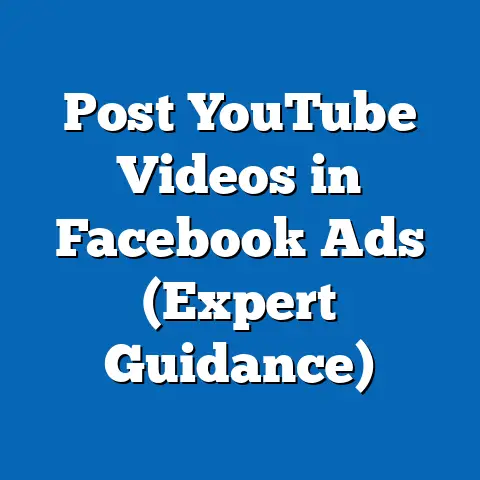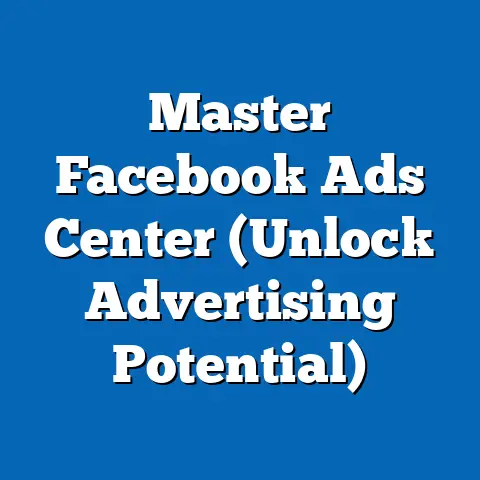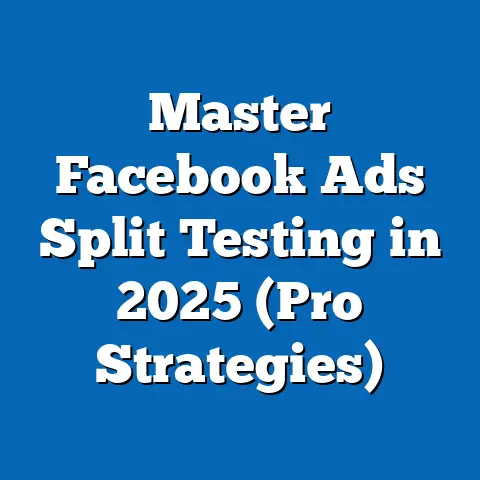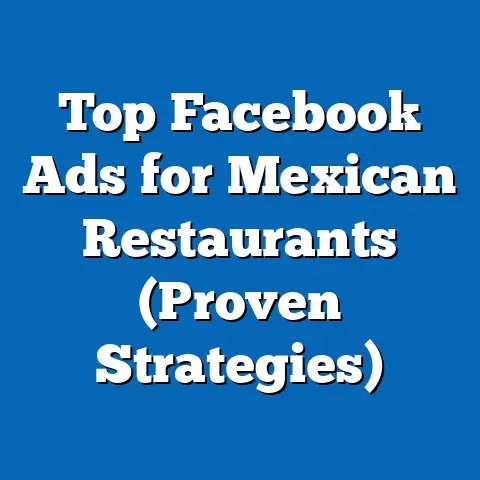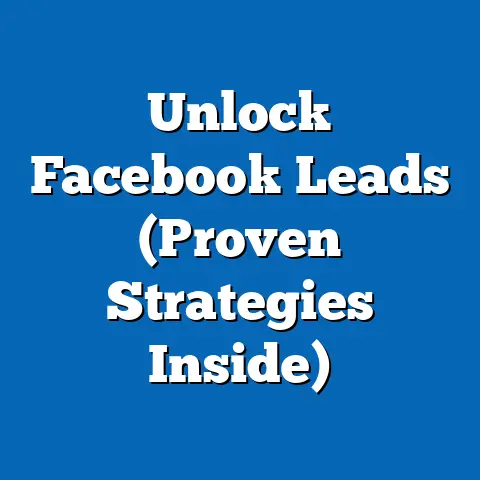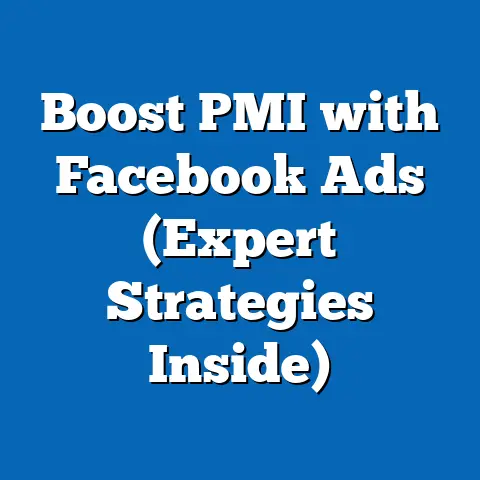Reduce Facebook Ads Bounce Rate (Expert Strategies Inside)
Reduce Facebook Ads Bounce Rate: Expert Strategies Inside
Imagine this: You’re a small business owner, let’s call you Sarah, who runs a boutique clothing store. You’ve spent weeks crafting the perfect Facebook ad campaign, targeting fashion-conscious millennials in your local area. You’re excited as you launch your ads, envisioning hordes of new customers flocking to your online store.
But then, the analytics start rolling in. The click-through rate (CTR) looks promising, but the bounce rate? It’s through the roof! People are clicking on your ad, but they’re leaving your landing page faster than you can say “fashion faux pas.” Sarah is frustrated, confused, and wondering where she went wrong.
Sarah’s experience isn’t unique. I’ve seen this scenario play out countless times. High bounce rates can be a silent killer for Facebook ad campaigns, draining your budget and leaving you with little to show for it. But don’t despair! Understanding bounce rates and implementing the right strategies can turn the tide.
Understanding Bounce Rate
So, what exactly is bounce rate? In the simplest terms, it’s the percentage of visitors who land on your website or landing page and leave without interacting with anything else. They “bounce” away without clicking on another page, filling out a form, or making a purchase.
In the context of Facebook Ads, a high bounce rate indicates that your ad is attracting visitors, but something is turning them off once they reach your landing page. This could be due to a variety of reasons, which we’ll explore shortly.
Why is a high bounce rate a problem? Let’s break it down:
- Lost Opportunities: Every bounced visitor is a potential customer who didn’t convert. You’re losing out on sales, leads, and brand awareness.
- Wasted Ad Spend: You’re paying for clicks that aren’t leading to anything. Your cost per acquisition (CPA) skyrockets, and your return on ad spend (ROAS) plummets.
- Poor Quality Scores: Facebook uses various factors to determine the quality of your ads, including landing page experience. A high bounce rate signals to Facebook that your landing page isn’t relevant or engaging, which can negatively impact your ad ranking and increase your costs.
Industry Benchmarks:
According to recent studies, the average bounce rate for landing pages across various industries ranges from 40% to 60%. However, this can vary significantly depending on the industry, type of landing page, and traffic source. For example, a blog post might have a higher acceptable bounce rate than a product page.
Takeaway: Understanding bounce rate is the first step to improving your Facebook ad performance. It’s a critical metric that tells you whether your ads are delivering the right visitors to the right place.
Identifying the Causes of High Bounce Rates
Now that we understand what bounce rate is and why it matters, let’s delve into the common culprits behind high bounce rates in Facebook ad campaigns. I’ve seen these issues crop up time and time again, so let’s break them down:
-
Mismatched Messaging:
- The Problem: Your ad promises one thing, but your landing page delivers something different. This disconnect can instantly turn visitors off.
- Example: Imagine your ad promotes a “50% off sale” on shoes, but when visitors click through, they find a limited selection of shoes on sale, and the rest are full price. They’re likely to bounce.
- My Insight: I’ve learned that consistency is key. Your ad copy, visuals, and landing page content must be seamlessly aligned.
-
Poor Landing Page Design:
-
The Problem: A cluttered, confusing, or visually unappealing landing page can drive visitors away. Poor user experience (UX) is a major bounce rate booster.
- Example: A landing page with too much text, irrelevant images, or a difficult-to-navigate layout can overwhelm visitors.
- My Insight: Keep it simple, clean, and focused. Your landing page should have a clear purpose and guide visitors towards a specific action.
-
Slow Loading Times:
-
The Problem: In today’s fast-paced digital world, people have zero tolerance for slow-loading websites. Studies show that even a one-second delay in page load time can significantly increase bounce rates.
- Example: A landing page with large, unoptimized images or excessive code can take ages to load, causing visitors to lose patience and bounce.
- My Insight: Speed matters! I always prioritize optimizing images, minimizing redirects, and leveraging caching to improve load times. Use tools like Google PageSpeed Insights to identify and fix performance bottlenecks.
-
Lack of Mobile Optimization:
-
The Problem: With the majority of Facebook users accessing the platform on mobile devices, a non-mobile-friendly landing page is a recipe for disaster.
- Example: A landing page that’s not responsive or has small, unreadable text on mobile devices will frustrate visitors and send them packing.
- My Insight: Mobile-first is the way to go. Ensure your landing page is fully responsive and provides a seamless experience on all devices.
-
Irrelevant Targeting:
-
The Problem: Targeting the wrong audience can lead to clicks, but not conversions. If your ad is shown to people who aren’t interested in your product or service, they’re likely to bounce.
- Example: Showing an ad for luxury watches to users who are primarily interested in budget-friendly electronics is unlikely to yield positive results.
- My Insight: Precision is paramount. Use Facebook’s audience insights to thoroughly research your target audience and refine your targeting criteria.
Mismatched Messaging:
- The Problem: Your ad promises one thing, but your landing page delivers something different. This disconnect can instantly turn visitors off.
- Example: Imagine your ad promotes a “50% off sale” on shoes, but when visitors click through, they find a limited selection of shoes on sale, and the rest are full price. They’re likely to bounce.
- My Insight: I’ve learned that consistency is key. Your ad copy, visuals, and landing page content must be seamlessly aligned.
-
Poor Landing Page Design:
-
The Problem: A cluttered, confusing, or visually unappealing landing page can drive visitors away. Poor user experience (UX) is a major bounce rate booster.
- Example: A landing page with too much text, irrelevant images, or a difficult-to-navigate layout can overwhelm visitors.
- My Insight: Keep it simple, clean, and focused. Your landing page should have a clear purpose and guide visitors towards a specific action.
-
Slow Loading Times:
-
The Problem: In today’s fast-paced digital world, people have zero tolerance for slow-loading websites. Studies show that even a one-second delay in page load time can significantly increase bounce rates.
- Example: A landing page with large, unoptimized images or excessive code can take ages to load, causing visitors to lose patience and bounce.
- My Insight: Speed matters! I always prioritize optimizing images, minimizing redirects, and leveraging caching to improve load times. Use tools like Google PageSpeed Insights to identify and fix performance bottlenecks.
-
Lack of Mobile Optimization:
-
The Problem: With the majority of Facebook users accessing the platform on mobile devices, a non-mobile-friendly landing page is a recipe for disaster.
- Example: A landing page that’s not responsive or has small, unreadable text on mobile devices will frustrate visitors and send them packing.
- My Insight: Mobile-first is the way to go. Ensure your landing page is fully responsive and provides a seamless experience on all devices.
-
Irrelevant Targeting:
-
The Problem: Targeting the wrong audience can lead to clicks, but not conversions. If your ad is shown to people who aren’t interested in your product or service, they’re likely to bounce.
- Example: Showing an ad for luxury watches to users who are primarily interested in budget-friendly electronics is unlikely to yield positive results.
- My Insight: Precision is paramount. Use Facebook’s audience insights to thoroughly research your target audience and refine your targeting criteria.
Poor Landing Page Design:
The Problem: A cluttered, confusing, or visually unappealing landing page can drive visitors away. Poor user experience (UX) is a major bounce rate booster.
Slow Loading Times:
The Problem: In today’s fast-paced digital world, people have zero tolerance for slow-loading websites. Studies show that even a one-second delay in page load time can significantly increase bounce rates.
Lack of Mobile Optimization:
The Problem: With the majority of Facebook users accessing the platform on mobile devices, a non-mobile-friendly landing page is a recipe for disaster.
Irrelevant Targeting:
The Problem: Targeting the wrong audience can lead to clicks, but not conversions. If your ad is shown to people who aren’t interested in your product or service, they’re likely to bounce.
Takeaway: Identifying the root causes of your high bounce rates is essential for developing effective solutions. Analyze your ads, landing pages, and targeting to pinpoint the areas that need improvement.
I’m going to share my go-to strategies for reducing bounce rates and turning those fleeting clicks into valuable conversions. I’ve honed these techniques over years of experience, and they’ve consistently delivered results.-
Crafting Compelling Ad Copy:
- The Strategy: Your ad copy is your first impression. It needs to grab attention, pique interest, and clearly communicate the value proposition of your offer.
- Actionable Tips:
- Highlight Benefits, Not Just Features: Focus on how your product or service solves a problem or improves the user’s life.
- Use Strong Action Verbs: Encourage clicks with compelling calls to action (CTAs) like “Shop Now,” “Learn More,” or “Get Started.”
- Keep it Concise and Clear: Avoid jargon and overly complex language.
- Use Numbers and Statistics: Data-driven claims can add credibility and increase click-through rates.
- Example: Instead of saying “Our software has advanced features,” try “Boost your productivity by 50% with our easy-to-use software.”
- My Insight: I’ve found that using questions in ad copy can be highly effective. For example, “Tired of wasting time on tedious tasks?” immediately engages the reader and makes them more likely to click.
-
Optimizing Landing Page Experience:
-
The Strategy: Your landing page is where the magic happens. It needs to be visually appealing, easy to navigate, and optimized for conversions.
- Actionable Tips:
- Use a Clear and Concise Headline: Reinforce the message from your ad and immediately tell visitors what your page is about.
- Provide High-Quality Visuals: Use professional-looking images and videos to showcase your product or service.
- Include Social Proof: Display testimonials, reviews, and ratings to build trust and credibility.
- Make Your Call to Action Prominent: Use a visually distinct button or form that encourages visitors to take the desired action.
- Remove Distractions: Eliminate unnecessary elements like sidebars, excessive navigation, and irrelevant links.
- Example: If your ad promotes a free e-book, your landing page should immediately offer the e-book download in exchange for an email address.
- My Insight: I always recommend using a single, focused call to action on your landing page. Don’t overwhelm visitors with too many options. Guide them towards the one action you want them to take.
-
A/B Testing:
-
The Strategy: A/B testing involves creating two or more versions of your ad or landing page and testing them against each other to see which performs better.
- Actionable Tips:
- Test One Element at a Time: Change only one variable (e.g., headline, image, CTA) to accurately measure its impact.
- Use a Control Group: Always have a baseline version to compare your variations against.
- Track Key Metrics: Monitor click-through rates, bounce rates, conversion rates, and cost per acquisition.
- Use Facebook’s Built-in A/B Testing Tools: Facebook offers tools for testing different ad creatives, audiences, and placements.
- Example: Test two different headlines on your landing page to see which one generates more leads.
- My Insight: I’ve seen incredible results from A/B testing. Even small tweaks can have a significant impact on your campaign performance. Don’t be afraid to experiment!
-
Utilizing Retargeting Strategies:
-
The Strategy: Retargeting involves showing ads to people who have previously interacted with your website or Facebook page. This can be a highly effective way to re-engage bounced visitors.
- Actionable Tips:
- Create a Custom Audience: Use Facebook Pixel to track website visitors and create a custom audience of people who bounced from your landing page.
- Craft Specific Retargeting Ads: Tailor your retargeting ads to address the reasons why visitors might have bounced in the first place.
- Offer a Special Discount or Incentive: Encourage bounced visitors to return with a special offer or discount.
- Example: If someone visited your product page but didn’t make a purchase, show them a retargeting ad with a 10% discount code.
- My Insight: Retargeting is a game-changer. It allows you to recapture lost opportunities and turn bounced visitors into loyal customers.
-
Improving Load Times:
-
The Strategy: As mentioned earlier, speed is crucial. Optimizing your landing page speed can dramatically reduce bounce rates.
- Actionable Tips:
- Compress Images: Use tools like TinyPNG or ImageOptim to reduce image file sizes without sacrificing quality.
- Minimize Redirects: Reduce the number of redirects on your landing page.
- Leverage Browser Caching: Enable browser caching to store static assets on visitors’ devices.
- Use a Content Delivery Network (CDN): A CDN can distribute your website content across multiple servers, improving load times for users around the world.
- Example: If your landing page has large, unoptimized images, compressing them can significantly improve load times and reduce bounce rates.
- My Insight: I’ve seen websites with load times of 5+ seconds drop their bounce rates by 20-30% simply by optimizing their images and leveraging caching.
-
Enhancing Audience Targeting:
-
The Strategy: Reaching the right audience is essential for reducing bounce rates. If your ads are shown to people who aren’t interested in your product or service, they’re likely to bounce.
- Actionable Tips:
- Use Facebook’s Detailed Targeting Options: Leverage Facebook’s demographic, interest, and behavior-based targeting options to narrow your audience.
- Create Lookalike Audiences: Use Facebook’s lookalike audience feature to find people who are similar to your existing customers.
- Exclude Irrelevant Audiences: Exclude demographics or interests that are unlikely to be interested in your offer.
- Example: If you’re selling organic baby food, target parents with young children who are interested in healthy eating and natural products.
- My Insight: I always recommend starting with a broad audience and then gradually refining your targeting based on performance data.
Crafting Compelling Ad Copy:
- The Strategy: Your ad copy is your first impression. It needs to grab attention, pique interest, and clearly communicate the value proposition of your offer.
- Actionable Tips:
- Highlight Benefits, Not Just Features: Focus on how your product or service solves a problem or improves the user’s life.
- Use Strong Action Verbs: Encourage clicks with compelling calls to action (CTAs) like “Shop Now,” “Learn More,” or “Get Started.”
- Keep it Concise and Clear: Avoid jargon and overly complex language.
- Use Numbers and Statistics: Data-driven claims can add credibility and increase click-through rates.
- Example: Instead of saying “Our software has advanced features,” try “Boost your productivity by 50% with our easy-to-use software.”
- My Insight: I’ve found that using questions in ad copy can be highly effective. For example, “Tired of wasting time on tedious tasks?” immediately engages the reader and makes them more likely to click.
-
Optimizing Landing Page Experience:
-
The Strategy: Your landing page is where the magic happens. It needs to be visually appealing, easy to navigate, and optimized for conversions.
- Actionable Tips:
- Use a Clear and Concise Headline: Reinforce the message from your ad and immediately tell visitors what your page is about.
- Provide High-Quality Visuals: Use professional-looking images and videos to showcase your product or service.
- Include Social Proof: Display testimonials, reviews, and ratings to build trust and credibility.
- Make Your Call to Action Prominent: Use a visually distinct button or form that encourages visitors to take the desired action.
- Remove Distractions: Eliminate unnecessary elements like sidebars, excessive navigation, and irrelevant links.
- Example: If your ad promotes a free e-book, your landing page should immediately offer the e-book download in exchange for an email address.
- My Insight: I always recommend using a single, focused call to action on your landing page. Don’t overwhelm visitors with too many options. Guide them towards the one action you want them to take.
-
A/B Testing:
-
The Strategy: A/B testing involves creating two or more versions of your ad or landing page and testing them against each other to see which performs better.
- Actionable Tips:
- Test One Element at a Time: Change only one variable (e.g., headline, image, CTA) to accurately measure its impact.
- Use a Control Group: Always have a baseline version to compare your variations against.
- Track Key Metrics: Monitor click-through rates, bounce rates, conversion rates, and cost per acquisition.
- Use Facebook’s Built-in A/B Testing Tools: Facebook offers tools for testing different ad creatives, audiences, and placements.
- Example: Test two different headlines on your landing page to see which one generates more leads.
- My Insight: I’ve seen incredible results from A/B testing. Even small tweaks can have a significant impact on your campaign performance. Don’t be afraid to experiment!
-
Utilizing Retargeting Strategies:
-
The Strategy: Retargeting involves showing ads to people who have previously interacted with your website or Facebook page. This can be a highly effective way to re-engage bounced visitors.
- Actionable Tips:
- Create a Custom Audience: Use Facebook Pixel to track website visitors and create a custom audience of people who bounced from your landing page.
- Craft Specific Retargeting Ads: Tailor your retargeting ads to address the reasons why visitors might have bounced in the first place.
- Offer a Special Discount or Incentive: Encourage bounced visitors to return with a special offer or discount.
- Example: If someone visited your product page but didn’t make a purchase, show them a retargeting ad with a 10% discount code.
- My Insight: Retargeting is a game-changer. It allows you to recapture lost opportunities and turn bounced visitors into loyal customers.
-
Improving Load Times:
-
The Strategy: As mentioned earlier, speed is crucial. Optimizing your landing page speed can dramatically reduce bounce rates.
- Actionable Tips:
- Compress Images: Use tools like TinyPNG or ImageOptim to reduce image file sizes without sacrificing quality.
- Minimize Redirects: Reduce the number of redirects on your landing page.
- Leverage Browser Caching: Enable browser caching to store static assets on visitors’ devices.
- Use a Content Delivery Network (CDN): A CDN can distribute your website content across multiple servers, improving load times for users around the world.
- Example: If your landing page has large, unoptimized images, compressing them can significantly improve load times and reduce bounce rates.
- My Insight: I’ve seen websites with load times of 5+ seconds drop their bounce rates by 20-30% simply by optimizing their images and leveraging caching.
-
Enhancing Audience Targeting:
-
The Strategy: Reaching the right audience is essential for reducing bounce rates. If your ads are shown to people who aren’t interested in your product or service, they’re likely to bounce.
- Actionable Tips:
- Use Facebook’s Detailed Targeting Options: Leverage Facebook’s demographic, interest, and behavior-based targeting options to narrow your audience.
- Create Lookalike Audiences: Use Facebook’s lookalike audience feature to find people who are similar to your existing customers.
- Exclude Irrelevant Audiences: Exclude demographics or interests that are unlikely to be interested in your offer.
- Example: If you’re selling organic baby food, target parents with young children who are interested in healthy eating and natural products.
- My Insight: I always recommend starting with a broad audience and then gradually refining your targeting based on performance data.
- Highlight Benefits, Not Just Features: Focus on how your product or service solves a problem or improves the user’s life.
- Use Strong Action Verbs: Encourage clicks with compelling calls to action (CTAs) like “Shop Now,” “Learn More,” or “Get Started.”
- Keep it Concise and Clear: Avoid jargon and overly complex language.
- Use Numbers and Statistics: Data-driven claims can add credibility and increase click-through rates.
- Example: Instead of saying “Our software has advanced features,” try “Boost your productivity by 50% with our easy-to-use software.”
Optimizing Landing Page Experience:
The Strategy: Your landing page is where the magic happens. It needs to be visually appealing, easy to navigate, and optimized for conversions.
- Use a Clear and Concise Headline: Reinforce the message from your ad and immediately tell visitors what your page is about.
- Provide High-Quality Visuals: Use professional-looking images and videos to showcase your product or service.
- Include Social Proof: Display testimonials, reviews, and ratings to build trust and credibility.
- Make Your Call to Action Prominent: Use a visually distinct button or form that encourages visitors to take the desired action.
- Remove Distractions: Eliminate unnecessary elements like sidebars, excessive navigation, and irrelevant links.
- Example: If your ad promotes a free e-book, your landing page should immediately offer the e-book download in exchange for an email address.
A/B Testing:
The Strategy: A/B testing involves creating two or more versions of your ad or landing page and testing them against each other to see which performs better.
- Test One Element at a Time: Change only one variable (e.g., headline, image, CTA) to accurately measure its impact.
- Use a Control Group: Always have a baseline version to compare your variations against.
- Track Key Metrics: Monitor click-through rates, bounce rates, conversion rates, and cost per acquisition.
- Use Facebook’s Built-in A/B Testing Tools: Facebook offers tools for testing different ad creatives, audiences, and placements.
- Example: Test two different headlines on your landing page to see which one generates more leads.
Utilizing Retargeting Strategies:
The Strategy: Retargeting involves showing ads to people who have previously interacted with your website or Facebook page. This can be a highly effective way to re-engage bounced visitors.
- Create a Custom Audience: Use Facebook Pixel to track website visitors and create a custom audience of people who bounced from your landing page.
- Craft Specific Retargeting Ads: Tailor your retargeting ads to address the reasons why visitors might have bounced in the first place.
- Offer a Special Discount or Incentive: Encourage bounced visitors to return with a special offer or discount.
- Example: If someone visited your product page but didn’t make a purchase, show them a retargeting ad with a 10% discount code.
Improving Load Times:
The Strategy: As mentioned earlier, speed is crucial. Optimizing your landing page speed can dramatically reduce bounce rates.
- Compress Images: Use tools like TinyPNG or ImageOptim to reduce image file sizes without sacrificing quality.
- Minimize Redirects: Reduce the number of redirects on your landing page.
- Leverage Browser Caching: Enable browser caching to store static assets on visitors’ devices.
- Use a Content Delivery Network (CDN): A CDN can distribute your website content across multiple servers, improving load times for users around the world.
- Example: If your landing page has large, unoptimized images, compressing them can significantly improve load times and reduce bounce rates.
Enhancing Audience Targeting:
The Strategy: Reaching the right audience is essential for reducing bounce rates. If your ads are shown to people who aren’t interested in your product or service, they’re likely to bounce.
- Use Facebook’s Detailed Targeting Options: Leverage Facebook’s demographic, interest, and behavior-based targeting options to narrow your audience.
- Create Lookalike Audiences: Use Facebook’s lookalike audience feature to find people who are similar to your existing customers.
- Exclude Irrelevant Audiences: Exclude demographics or interests that are unlikely to be interested in your offer.
- Example: If you’re selling organic baby food, target parents with young children who are interested in healthy eating and natural products.
Takeaway: Implementing these strategies can significantly reduce your Facebook ads bounce rates and improve your overall campaign performance. Remember to test, analyze, and optimize continuously to achieve the best results.
Case Studies and Success Stories
Let’s bring these strategies to life with some real-world examples. I’ve seen businesses of all sizes successfully reduce their Facebook ads bounce rates by implementing the techniques I’ve shared.
Case Study 1: Local Restaurant
- The Challenge: A local restaurant was running Facebook ads to promote their lunch specials, but they had a high bounce rate.
- The Solution: They revamped their landing page to include high-quality photos of their lunch dishes, a clear and concise description of the specials, and a prominent “Order Now” button. They also optimized their ad copy to highlight the convenience and affordability of their lunch offerings.
- The Results: Their bounce rate decreased by 35%, and their online orders increased by 20%.
Case Study 2: E-commerce Store
- The Challenge: An e-commerce store selling handmade jewelry was struggling with a high bounce rate on their Facebook ad campaigns.
- The Solution: They implemented retargeting ads to re-engage bounced visitors, offering a 10% discount on their first purchase. They also improved their landing page load times by compressing images and leveraging browser caching.
- The Results: Their bounce rate decreased by 40%, and their conversion rate increased by 15%.
Success Story: Online Education Platform
- The Challenge: An online education platform was experiencing a high bounce rate on their Facebook ads promoting a free trial of their courses.
- The Solution: They A/B tested different headlines and visuals on their landing page to see which resonated best with their target audience. They also refined their audience targeting to focus on users who were actively searching for online courses in their niche.
- The Results: Their bounce rate decreased by 25%, and their free trial sign-ups increased by 30%.
Takeaway: These case studies demonstrate that reducing bounce rates is achievable with the right strategies and a commitment to continuous optimization.
Conclusion
Reducing bounce rates is a critical component of successful Facebook advertising. By understanding the causes of high bounce rates and implementing the expert strategies I’ve shared, you can turn those fleeting clicks into valuable conversions and maximize your return on ad spend.
Remember, the digital marketing landscape is constantly evolving. Stay curious, keep testing, and never stop optimizing. Your efforts will pay off in the long run. Now go forth and conquer those bounce rates!

